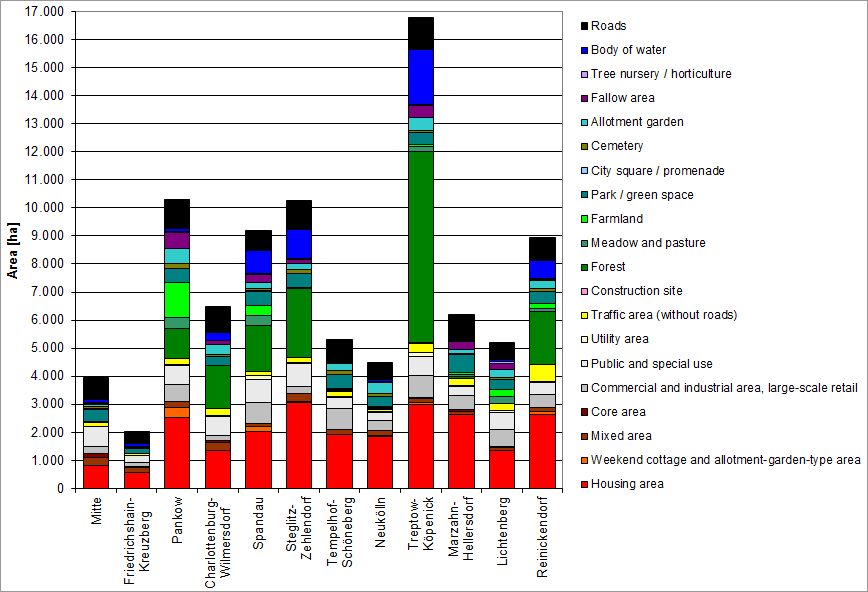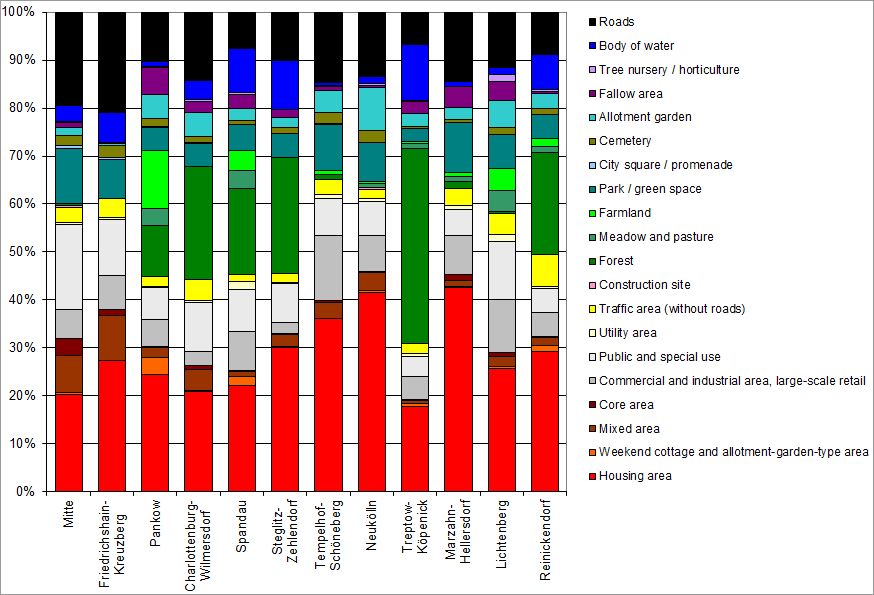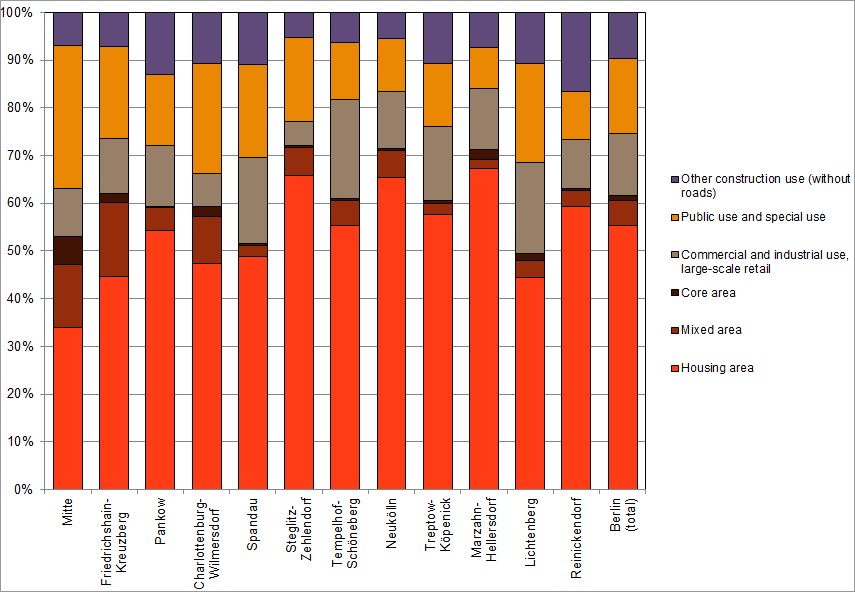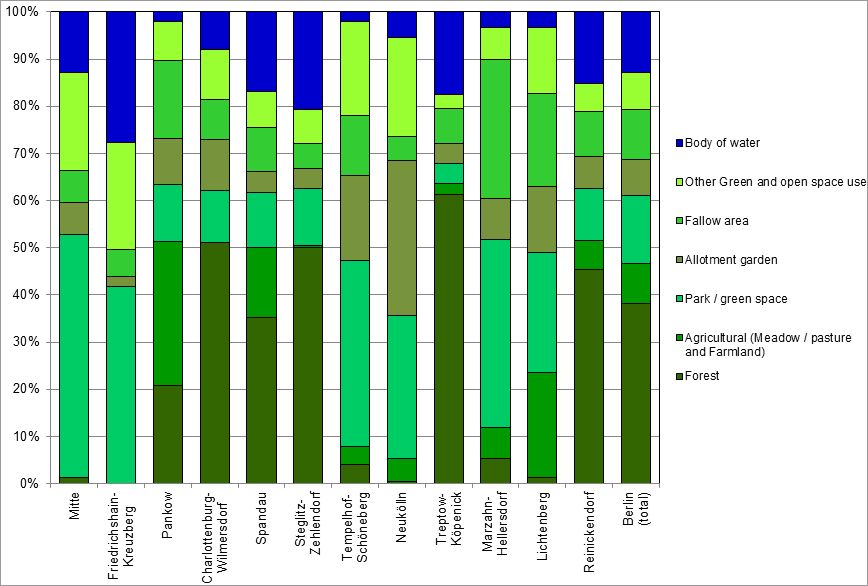Each mapping unit for Actual Use of Built-Up Areas and for the Inventory of Green and Open Space is described separately below.
The Categories for the Map “Actual Use of Built-Up Areas” (06.01)
Block areas are shown as Housing if they are primarily used for residential purposes. Certain residentially related service enterprises, utilities and local green spaces are also included. Residential areas include both the dense inner-city areas and the open housing estates at the periphery of the city.
The Mixed use area may be similar to primarily residential areas in appearance. However, the housing is more strongly interspersed with commercial and service enterprises (department stores, offices, etc.), cultural facilities and small businesses. In exceptional cases, housing may account for as much as two thirds of the area, but as a rule, commercial, service enterprises and other businesses predominate.
In some cases, Mixed use areas are characterized by a high share of retail enterprises, tradespeople, or small businesses, or extensively used commercial space and the associated sheds, workshops or warehouse/ storage areas, while residential use is clearly secondary, and accounts for only one third or at most half of such an area. If such areas are underused, they may be interspersed with fallow areas.
The negative impact of commercial use on a neighbouring residential area usually ranges between minimal and moderate, but is in some cases high.
Areas with high use intensity and density are presented as Core use areas. They are found exclusively in the central areas of the inner city, and in the main borough centres. These are areas of particular importance for commercial, private and public services, and for cultural and scientific institutions. To some extent, higher-level public facilities, especially federal administrative offices, embassies, etc. in inner-city areas are assigned to this category.
Structurally, major differences are apparent between various parts of the city. The spectrum ranges from block structures of the Wilhelminian period to high-rise buildings built in recent decades. In general, these areas are characterized by high urban density and a high degree of imperviousness.
The characteristics of a Commercial and industrial, large-scale retail area include large industrial buildings, warehouses and storage/ parking areas. The housing share is subordinate, with around one third at a maximum. This category also includes railway freight yards and commercial areas on railway land, waterside lots of a clearly commercial character (shipyards, boatyards, etc.), as well as large-scale retail and other space-consuming commercial operations, including the parking facilities belonging to them. Disturbance due to noise and emissions can be rated from moderate to very high.
Sites of the Public use category include cultural, university and research, health care, administrative, security and law-enforcement facilities, religious institutions such as churches, child care centres and other youth recreational centres, schools and sports facilities. A few children’s playgrounds and retirement homes are also included in this category.
Special use areas include such areas as the Olympic Stadium and the Messegelände trade fair complex, as well as large restaurants in recreational areas oriented toward group tours.
The category Utility area includes power, gas, water, district heating and facilities of the waste removal and sewage departments.
Public roadways are generally not included in the use mapping process. The Traffic areas as described here therefore include primarily railway lands, private roadways, as well as Tegel Airport. Moreover, traffic islands and median strips also count as Traffic areas, to the extent that they are marked on the block maps. “Green spaces associated with traffic areas” – i.e., along roads, rail lines and bodies of water – are also assigned to this category in the mapping process, albeit as dual use areas which are also counted as Green and open spaces.
Freight railway stations and commercial areas on railway land are, by contrast, not counted as traffic areas, but are rather assigned to the category “Commercial and industrial use, large-scale retail”.
Parking spaces including parking garages were only considered to be traffic areas if they occupy an entire block. Parking areas with ascertainment sizes exceeding one hectare, but which are located within a single block in combination with other uses (e.g. residential use), are not separated off by a block segment partition, but are rather assigned to the dominant use.
The Traffic area category also includes railway lines and operating facilities of the subway (U-Bahn), the urban railway (S-Bahn), the long distance railway and the tram system, and also parts of the underground/subway lines which are outside of the tunnels in open cuts.
The Central Bus Station (ZOB), and the bus and tram depots are also assigned to this category.
Weekend cottages are by definition not permanently inhabited, and are primarily used for recreation. This category also includes areas with allotment-garden-type use, which are not listed in the “Berlin Allotment Gardens” map developed by the Senate Department for Urban Development and the Environment as per the Federal Allotment Gardens Law.
Compared to a single-family home area with residential use, these blocks are generally characterized by a smaller structural volume and a smaller-scale subdivision of the lots. Compared with Allotment garden areas however, these areas are more densely built-up, and the lots are generally larger.
Areas classified as Construction sites are those with a typical construction site character, as a rule, with open ground. Once the foundations and first floors of the new building are recognizable, it will be classified according to its planned use.
Categories of the Map “Inventory of Green and Open Space” (06.02)
The category Forest includes all wooded areas of the Berlin forests, as well as those wooded stands outside the Berlin forests which appear clearly in aerial photography as forest stands. Besides the wooded areas of the Berlin forests, this includes reforested former sewage farms and other fallows with forest-like vegetation.
Not included in this category are forest-like parks, such as the Großer Tiergarten or the Klein-Glienicke People’s Park, which is part of the parkland inventory of Berlin. Such areas have been assigned to the use category Park / green space and to the area type Forest.
Body of water includes all natural bodies of water, e.g. rivers, lakes, ponds, and also canals, retaining and seepage basins of the Berlin Water Authority, provided they are recognizable as water surfaces (or as water engineering structures).
The category Meadow and pasture includes meadows, pastures and enclosures used for agricultural purposes, and also experimental areas used by the universities for similar purposes, and former sewage fields, regardless of how the products of these fields are used.
Farmland includes areas identified as being used for agricultural purposes. The difference from the category Meadow and pasture is that in this case, the land is periodically ploughed, sown, fertilized and harvested.
To determine the use of meadow and pasture and farmland, the database of the digital field block register was analyzed for the first time. The use categories Meadow and pasture and Farmland may alternate over the course of only a few years in the same area. For these two agricultural use categories, it is therefore particularly important that the mapping process reflect the current state of knowledge.
The category Tree nursery / horticulture includes both the acreage of private tree nurseries and garden centers, and of borough garden centers and city horticultural schools. These are areas with predominantly outdoor cultivation. Facilities with purely indoor operations are rather assigned to the category Commercial and industrial use.
Block areas with borough garden centres, horticultural schools, the work yards of the horticultural offices, and certain research facilities, such as the Institute for Crop Research of the Technical University Berlin and the corresponding teaching and experimental fields of the universities, are mapped as dual use together with Public use /special use. Due to their high demand for space, tree nurseries and horticultural facilities are largely located at the outskirts of the city.
In addition to those facilities listed in the Directory of Green Spaces compiled by the Senate Department for Urban Development and the Environment, the category Park / green space includes other green spaces, if they are similar in appearance to a publicly accessible park facility and are apparently subject to regular maintenance gardening. Thus, for example, well maintained green spaces associated with traffic areas along roads and motorways are assigned to this category, albeit as dual purpose areas with traffic use. Smaller, public-square-like green spaces and playgrounds are also mapped as a Park / green spaces, provided they are less than approx. one third impervious; otherwise they fall under the category of City square / promenade. Blocks of the use category Park / green space are also generally assigned to the area type Park / green space. Very extensive parks and recreational facilities characterized almost exclusively by extensively maintained or non-maintained wooded or meadow-like areas are in some cases assigned to the area types Forest or Fallow area (e.g., the Klein-Glienicke People’s Park). Some special, not freely accessible facilities, such as the Botanical Gardens or Zoologischer Garten or Tierpark Friedrichsfelde, are mapped as a Park / green space, but with the dual purpose assignment as Public use / special use. Other public facilities, too, may be associated with green facilities. These parklands are then not delimited separately, even if their size exceeds the ascertainment limit of one ha. They may be mapped as dual purpose areas, in order to also connote their predominantly “green” character.
By contrast however, private outdoor facilities, playgrounds, etc. in residential areas are not mapped as a Park / green space, since they are part of the character of the residential use of those areas, and the open space structure of these blocks is further differentiated in the type assignment (see comments on the Environmental Atlas Maps 06.07/06.08).
City squares / promenades are the public spaces of urban living. City squares serve as places of sojourn for leisure and recreational purposes, as meeting areas, market places etc., and are often located in front of railway stations and other representative public buildings.
Promenades are spacious pathways that provide pedestrians and cyclists with space for movement away from road traffic. Promenade may also include some more highly impervious median strips, provided they are not used as parking lots. Squares and promenades generally have a higher degree of imperviousness than parks and green spaces.
A Cemetery includes both areas currently used for burial purposes and former cemeteries, provided they are still recognizable as such.
The data on the inventory of cemeteries in Berlin maintained by the Senate Department for Urban Development and the Environment is the basis for the scope of these areas. Honorary graves and monuments, on the other hand, are not assigned to the area type Cemetery, although they are recorded in the Berlin inventory of cemeteries; they are mapped as Public and special use, and assigned to the area type Culture.
However, cemeteries are not generally considered areas of Public and special use. Only when usually small-scale blocks are largely occupied by a church building, and the surrounding cemetery is only a subordinate feature will a dual use as Public and special use be assigned, in which case the block is then assigned to the area type Church. However, if a church or chapel is located on a large cemetery only in a subordinate function, no dual use is assigned.
Structurally, cemeteries differ from one another mainly in terms of their stock of trees. While older cemeteries and forest cemeteries are essentially characterized by their very old stocks of trees, many newer cemeteries are still largely without larger trees.
The basis for the assignment and delimitation of the category Allotment garden is the data base compiled by the Senate Department for Urban Development and the Environment of Berlin allotment gardens, which record the allotment gardens with appropriate use, as defined by the Federal Allotment Garden Law.
Other areas with similar use characteristics are classified as Weekend cottages and allotment-garden-type use.
A Fallow area is an area that is currently not in use and not maintained, on which variegated stands of vegetation can often develop.
A distinction is made between a Fallow free of vegetation on the one hand, which includes mostly excavations, soil or rubble dumps, or demolition areas, where no vegetation has yet taken root, due to the fact that their utilization has only recently been abandoned. In some cases, the site conditions ensure that no vegetation will enter the area for some time. These may be brownfields where little vegetation grows due to the very high degree of imperviousness, or else sand dunes and beaches, on which spontaneous growth of vegetation occurs only very slowly, due to a lack of nutrients, or due to regular disturbances.
Another category of fallows is Fallow with predominantly meadow-like vegetation. On open brownfield sites, a vegetation of ruderal perennials and grasses often establishes itself during the first few years. Especially on nutrient-poor sites, this vegetation can remain relatively constant over the course of several years. In general, however, unstable conditions prevail.
All brownfield sites which cannot be clearly assigned to one of the other fallow or forest categories are mapped as Fallow with mixed vegetation – meadows, trees, bushes. The development of vegetation on a fallow site depends on many conditions, such as the abiotic site conditions, the initial vegetation and anthropogenic influences, so that on long-fallow sites, various successional stages often alternate within a small area.
If, on the other hand, an area is covered almost entirely with trees, it will be assigned to the category Forest.
The category Sport facility includes both covered and uncovered sports facilities. All sports use areas are at the same time mapped as Public and special use.
Uncovered sports facilities are outdoor facilities used for sports, physical activity and leisure activities. These include not only sports fields, swimming pools and beaches, but also riding, golfing, archery and water sports areas. The latter are characterized by small dockyards, boat and club houses, parking lots etc., with a high proportion of green space. Clearly commercial water sports areas (dockyards, boat-building facilities, etc.) are assigned to the category Commercial and industrial use. Some fairly extensively used beaches (without changing rooms, kiosks, etc.) are assigned to fallow or forest categories.
The covered sports facilities include primarily those housed in halls, such as indoor pools and ice skating rinks, and also stadiums and multipurpose halls, in which non-sporting events such as concerts may also be held.
Use Distribution for Berlin
The following tables and figures show the shares of all use types in relation to the total area of Berlin. It should be noted that 1,964 areas have both a land use category of built-up areas (nos. 10 through 90) and of non-built-up areas (nos. 100 through 200).
With this approach, major potential green and open space areas can be displayed on other use areas. This applies particularly to Public and special use sites, Utility areas, Commercial and industrial areas and Traffic areas. These areas are shown on both maps, i.e. differently (cf. the explanations of dual use in the Methodology section).
Since for the evaluation of area shares, each area only once can be considered once, both cases– green priority and construction priority – have been calculated separately.
The calculations are based on the area size data of the ISU. The block areas were calculated with the help of the Geographic Information System (GIS) based on the block segment map ISU5.
Table 2 shows the absolute and percentage area shares of different uses of the total area of Berlin.

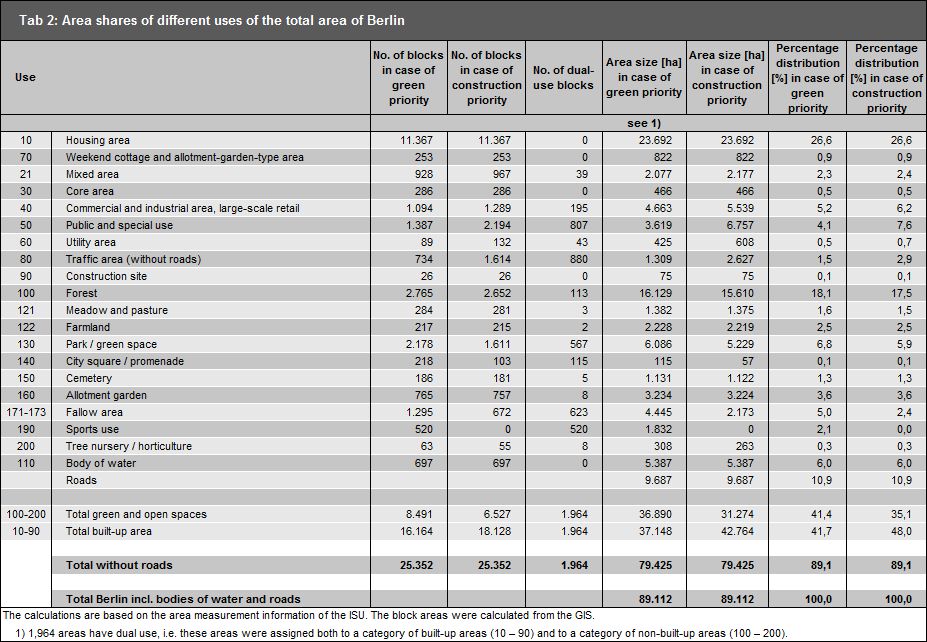
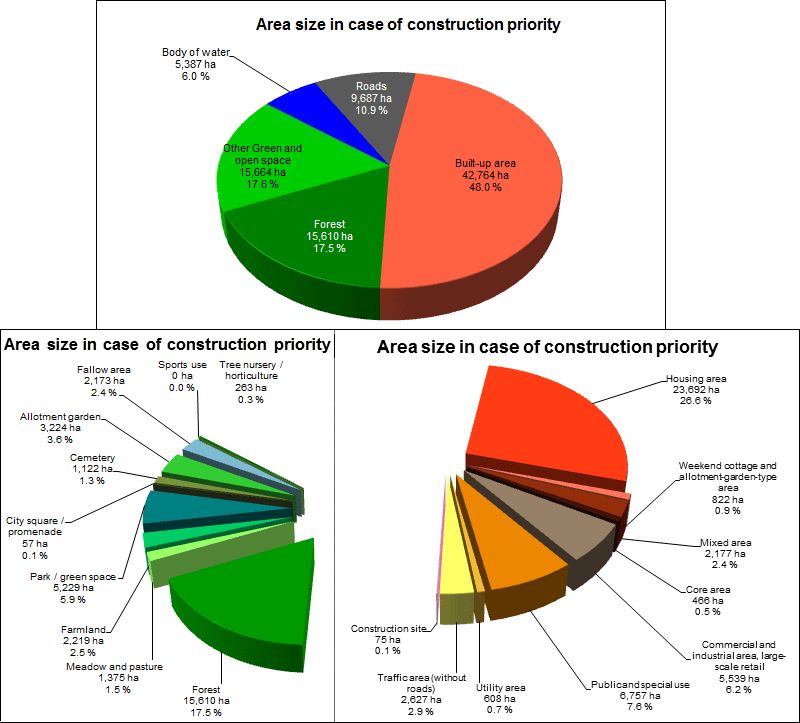
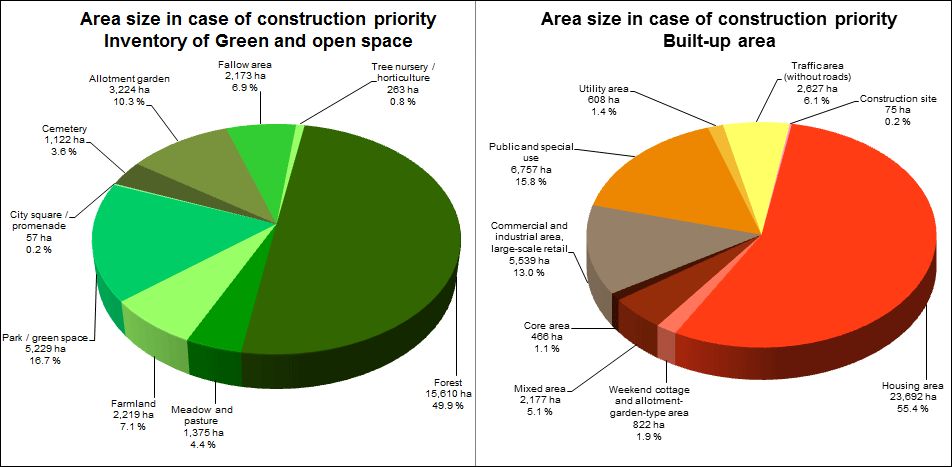
![Enlarge photo: Tab. 3: Area shares of different uses of the total area of Berlin [in ha], area sizes based on the ISU5 block segment map (in case of construction priority), as of December 31, 2015](/imgscaler/nTEtLfKEoKagfd1buPVxwghuL3zwlFiTyTm68NQZkLE/ropen/L3N5czExLXByb2QvdW13ZWx0YXRsYXMvX2Fzc2V0cy9udXR6dW5nL2ZsYWVjaGVubnV0enVuZy9lbi10YWJlbGxlbi9tYXhzaXplXzliOGQ4MDU4MzE2ZWRhNjUyMTVjMzkzNDdjYjNkMWM1X2V0ZTYwMV8wMy5naWY.jpg?ts=1681470337)
